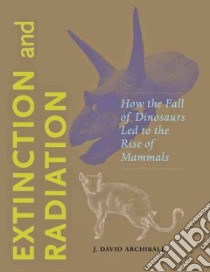Extinction and Radiation - 9780801898051
Un libro in lingua di Archibald J. David edito da Johns Hopkins Univ Pr, 2011
- € 64.50
- Il prezzo è variabile in funzione del cambio della valuta d’origine
In the geological blink of an eye, mammals moved from an obscure group of vertebrates into a class of planetary dominance. Why? J. David Archibald's provocative study identifies the fall of dinosaurs as the factor that allowed mammals to evolve into the dominant tetrapod form.
Archibald refutes the widely accepted single-cause impact theory for dinosaur extinction. He demonstrates that multiple factors—massive volcanic eruptions, loss of shallow seas, and extraterrestrial impact—likely led to their demise. While their avian relatives ultimately survived and thrived, terrestrial dinosaurs did not. Taking their place as the dominant land and sea tetrapods were mammals, whose radiation was explosive following nonavian dinosaur extinction.
Archibald argues that because of dinosaurs, Mesozoic mammals changed relatively slowly for 145 million years compared to the prodigious Cenozoic radiation that followed. Finally out from under the shadow of the giant reptiles, Cenozoic mammals evolved into the forms we recognize today in a mere ten million years after dinosaur extinction.
Extinction and Radiation is the first book to convincingly link the rise of mammals with the fall of dinosaurs. Piecing together evidence from both molecular biology and the fossil record, Archibald shows how science is edging closer to understanding exactly what happened during the mass extinctions near the K/T boundary and the radiation that followed.
Informazioni bibliografiche
- Titolo del Libro in lingua: Extinction and Radiation
- Sottotitolo: How the Fall of Dinosaurs Led to the Rise of Mammals
- Lingua: English
- Autore: Archibald J. David
- Editore: Johns Hopkins Univ Pr
- Collana: Johns Hopkins Univ Pr (Hardcover)
- Data di Pubblicazione: 04 Febbraio '11
- Genere: SCIENCE
- Argomenti : Dinosaurs Extinction Cretaceous-Paleogene boundary Mammals, Fossil
- Pagine: 108
- Dimensioni mm: 279 x 215 x 19
- ISBN-10: 0801898056
- EAN-13: 9780801898051


